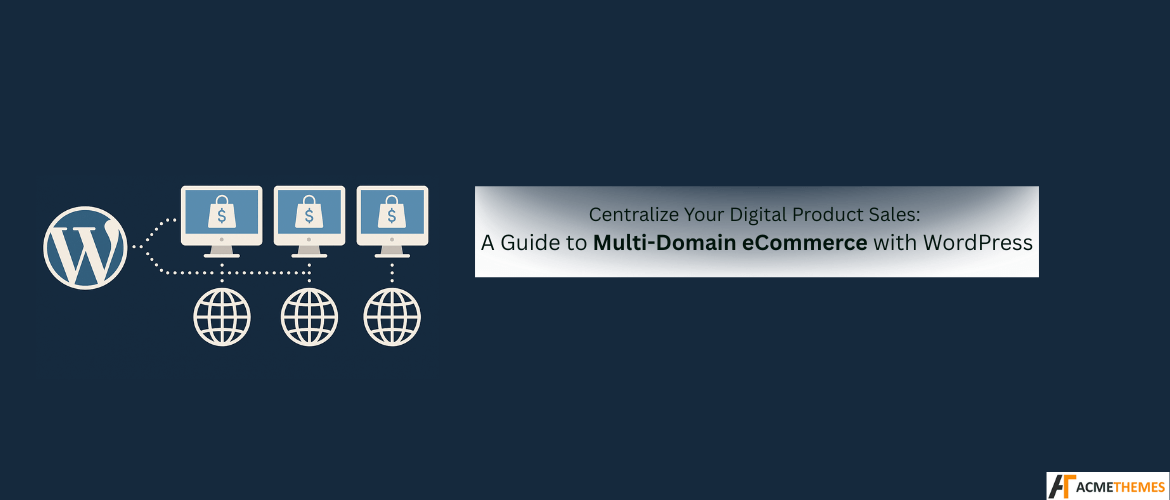Centralize Your Digital Product Sales: A Guide to Multi-Domain eCommerce with WordPress
Selling digital products is one of the most scalable ways to generate income online. But what if you want to market your products across multiple domains or niche sites without having to install and manage separate WordPress installations? Fortunately, there are smart ways to sell digital products on multiple domains using a single WordPress installation. This saves time, reduces maintenance, and offers centralized control over your store.
In this guide, we’ll walk you through how to do it, including the tools, setup steps, and best practices.
Table of Contents
Why Sell on Multiple Domains from One WordPress Site?
Using a single WordPress installation to manage digital product sales across multiple domains has several benefits:
- Centralized Management: No need to juggle multiple admin dashboards.
- Cost Efficiency: Save on hosting and plugin costs.
- Streamlined Updates: Maintain themes, plugins, and products from one place.
- Branding Flexibility: Customize the front end for different audiences while managing everything from one backend.
What You’ll Need
To achieve this setup, you’ll need:
- A WordPress website with WooCommerce or Easy Digital Downloads (EDD) installed.
- A Multisite Network or a headless/multi-store architecture.
- Domain mapping tools or plugins.
- Optional: A membership/download manager if selling gated content.
Method 1: Using WordPress Multisite with Domain Mapping
Step 1: Set Up WordPress Multisite
Enable multisite on your main WordPress installation by editing the wp-config.php and .htaccess files. This allows you to create sub-sites under one WordPress instance.
Step 2: Install Domain Mapping Plugin
Use a plugin like Multiple Domain Mapping on Single Site to map each sub-site to a different domain.
Step 3: Install WooCommerce or EDD on the Network
Activate your eCommerce plugin network-wide or only on the sites where needed. Share digital products by exporting/importing them, or use a centralized product feed.
Step 4: Share Product Files
Use a shared file storage solution (like Amazon S3 or WP Offload Media) to deliver digital downloads from a single storage location across all domains.
Method 2: Using a Headless or Centralized Storefront Model
Step 1: Use WooCommerce REST API
Create one WooCommerce-powered WordPress site as your central store. Use its REST API to connect your front-end sites (built with WordPress, React, or any other framework).
Step 2: Build Frontends for Each Domain
Your other domains can be simple landing pages or full-fledged sites that fetch products via API. When customers buy, they’re directed to the main domain for checkout.
Step 3: Customize Experience
Each domain can display unique branding, content, and product categories while still pulling product data from the central store.
Best Plugins and Tools,
- WP Multisite Enhancements: To improve the admin experience on multisite.
- WooCommerce API Manager: For license-based digital sales.
- EDD Frontend Submissions: If allowing multiple vendors per domain.
- WP Offload Media: Centralizes media storage for all domains.
SEO and Analytics Considerations
- Use Canonical URLs: Avoid duplicate content penalties by setting canonical URLs correctly.
- Separate Google Analytics Tags: Track domain performance individually.
- Custom Robots.txt: Control crawling behavior for each domain.
Final Tips
- Keep your branding consistent across domains where appropriate.
- Ensure your payment gateway supports multi-domain transactions.
- Monitor download access and license management to avoid piracy.
Conclusion
Selling digital products on multiple domains from a single WordPress installation is not only possible—it’s a smart move for digital entrepreneurs who want to scale without adding complexity. Whether you go with WordPress Multisite or a headless setup using WooCommerce API, you can manage your digital empire efficiently and professionally.
If you’re looking for a fast, responsive, and SEO-friendly theme to power your multi-domain eCommerce project, check out the premium and free themes at Acme Themes. Our themes are built with performance and user experience in mind.
Also, explore:
Let us know in the comments if you’ve tried this setup or need help with specific plugins. Happy selling!
